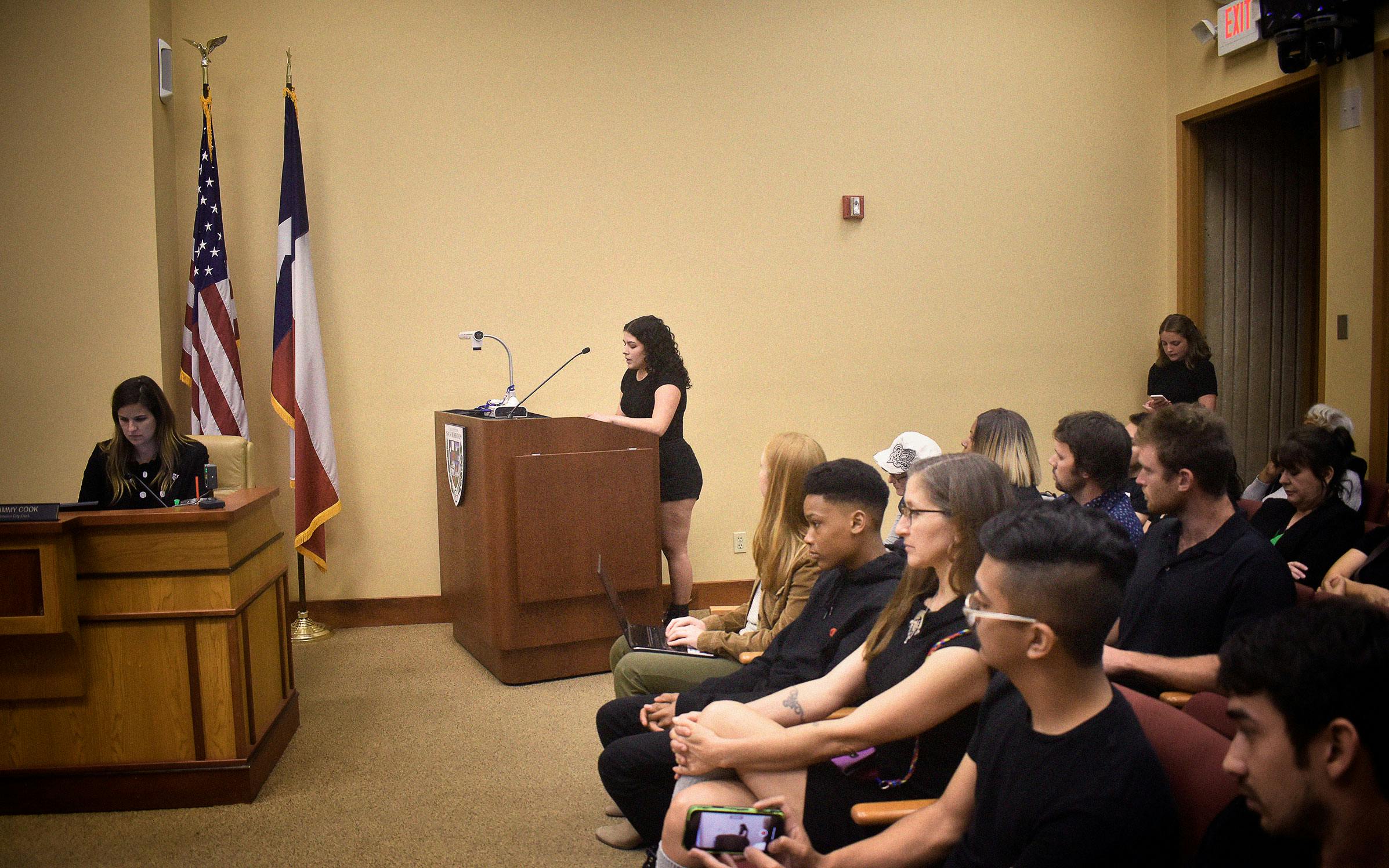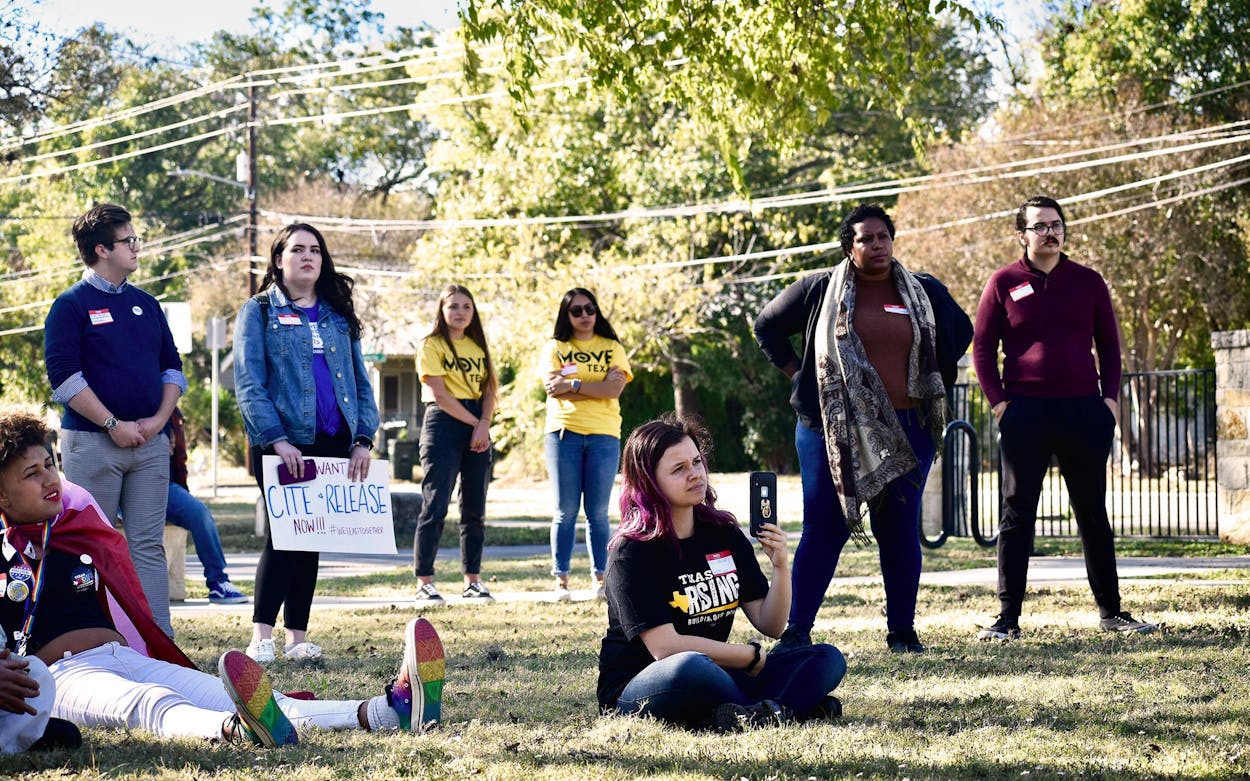In the early nineties, at the peak of the war on drugs, San Marcos was a hotbed for marijuana activism. The city made national headlines when seven advocates for decriminalization were arrested for smoking weed outside the county jail in an act of civil disobedience. “They are just old hippies going through a change of life,” Paul Hastings, then Hays County sheriff, told the New York Times in 1991. “They’re still looking for a cause.”
The protests didn’t persuade local law enforcement leaders to ease their “zero-tolerance” policies that aimed to incarcerate people on low-level drug charges. In 1999, a Hays County narcotics task force raided the home of 25-year-old Rusty Windle, an electrician’s apprentice, suspecting he was a low-level marijuana dealer. He wasn’t, but he was shot and killed during the raid.
Local activists in San Marcos still talk about Windle’s death today. But the criminal justice landscape—and the makeup of the city itself—has changed drastically since then. Once a quiet college town that was predominantly white, San Marcos’s population exploded in this century, and it quickly became a majority-minority city. In May, after months of heated debate, San Marcos became the first city in Texas to implement a cite-and-release ordinance that requires that police officers issue citations to low-level offenders, rather than arresting and jailing them before their court hearings. The landmark measure, passed despite opposition from a local police union, reflects the city’s changing identity, and could signal a shift in similarly changing cities across the state.
In 2007, the Texas Legislature passed a bill allowing local leaders to implement “cite and release” policies. But throughout the state, and particularly in San Marcos, low-level arrests continued to clog county jails. Minor marijuana possession has been the leading reason for arrest in San Marcos since 2013; in 2015, nearly 15 percent of the Hays County jail population was held on misdemeanor charges.
By 2016, the 27-year-old jail with three hundred beds was so overcrowded that the county had to pay to house arrestees as far away as Waco, an hour and a half drive away. That same year, officials introduced a $100 million bond package to expand the county jail and build a new public safety building to accommodate the influx of inmates. It passed with just 51 percent of the vote (other bond measures allowing the county to take on more debt passed with far more support: 59 percent of voters simultaneously approved a $131 million measure allocating money for road construction).
The overcrowding issue at the Hays County jail has grown worse since: In 2018, Hays County paid $4.3 million to outsource inmates to other Texas counties, a 7,000 percent increase since 2014.
“It’s a self-fulfilling prophecy,” San Marcos criminal justice reform activist Eric Martinez said of the planned jail expansion. “If you build it, they will come.”
Amid the calls for a larger jail, a new wave of activism began to sweep the city. In 2017, Martinez and a few other San Marcos residents formed Mano Amiga, a social justice organization. Activists there primarily worked to defend immigrants who were set for deportation after being arrested for low-level offenses, but while doing that, they noticed something else in the data: San Marcos police officers were almost always choosing to send people to jail for citation-eligible offenses, particularly if that person was black.
In 2018, police gave only 20 citations among more than 330 interactions that were eligible for cite-and-release. Of 72 black people stopped for a citation-eligible offense that year, 72 were arrested rather than cited and released. Of the 20 times that police issued citations for eligible offenses, 7 were issued to white non-Hispanics, and 13 to people identified as white Hispanics.
Notably, nearly one-third of those arrested by the city for low-level marijuana offenses were black, though only 5 percent of the city’s population was.
Along with the city’s changing demographics, progressive, reform-minded officials were elected into key positions. In 2018, Ruben Becerra was elected as county judge on a platform that promised criminal justice reforms, such as reducing spending on the county jail. Mark Rockeymoore, a former PhD student who was arrested one night in 2005, couldn’t make bail, and struggled to find employment for years after, was elected to the San Marcos City Council. He was committed to ending unnecessary arrests.
“People need to know that they can come back from the worst day of their lives and not have their entire life ruined from it,” Rockeymoore said.
The stage was set for reform.

During a meeting in September last year, moments before the city council was set to swear in the new interim chief of police, Mano Amiga called on the council to introduce measures that would require police to issue citations more frequently. Several San Marcos residents who spoke during the meeting’s public comment period echoed the call.
“In this county, we treat our pets better than we treat our people,” said Faylita Hicks, who was arrested in 2010 and served 45 days in the Hays County jail after failing to appear in court for a low-level, nonviolent offense. “We give them yards, and parks, and fight for their lives. But when it comes to people of color, especially black people, we do not give them such options.”
“When officers use their discretion and still choose to arrest low-level offenders, they are choosing to lock a human into a cage that we wouldn’t even put our dogs in,” Hicks added. “There is a bias among the officers, and the discretion has been unfairly doled out to people who are not of color.”
The city council was largely receptive to a cite-and-release policy, and even the interim police chief, Bob Klett, signaled that he supported the idea. So, too, did much of the San Marcos community—a survey conducted by a local newspaper later showed that 63 percent of respondents favored an ordinance that mandated that officers issue citations for eligible offenses.
But there was dissent within the San Marcos Police Department. Jesse Saavedra, president of the San Marcos Police Officers’ Association, the city’s police union, was the ordinance’s most outspoken critic. He argued that any cite-and-release ordinance would lead to an increase in crime and would limit officer discretion to the point that citation-eligible crimes, such as theft, would essentially be the same as a traffic ticket.
“Setting the precedent of a coalition of organizations in the community coming in, writing a policy that is then to be adopted by the highest policy-making body in the city, it’s something that the [police officers’] association is particularly uncomfortable with,” Martinez said. “Non-officers telling officers how to do their job, is basically what it chalks up to.”
At one point, proponents of the measure say, the police association expressed concern that the ordinance would allow criminals to steal garden gnomes with impunity. “They would give these hypothetical situations that were so far from reality,” said Anita Gupta, an Austin-based attorney with the Immigrant Legal Resource Center, who helped Mano Amiga and the city council write the ordinance.
The debate turned ugly. In early April, Saavedra sent an email to the city council, warning that if the measure passed a final vote, the police officers’ association would recommend its members issue citations in every case—no matter how large the offense. He expressed concern that not doing so would open officers up to civil liability if they applied their discretion in a way that potentially violated the ordinance.

Weeks before the ordinance was set to go before the council for a final vote, the San Marcos Corridor News published a pair of digital flyers featuring photos of the council members who supported the ordinance, along with claims that serious crimes would go unpunished if the ordinance passed. “When we catch the peeping Tom who has been looking at your daughter, we will issue a citation,” read text next to a photo of Rockeymoore.
In another flyer, photos of four councilmembers sat beneath text that read: “Are the council member [sic] ok with 9 Marijuana Related Murders?” At the bottom of both posters were the logos of the San Marcos Police Officers’ Association, and CLEAT, a statewide police union. (Saavedra did not respond to Texas Monthly’s request for an interview.)
On April 21, during a city council meeting held virtually because of the coronavirus pandemic, the cite-and-release ordinance was up for a final vote. The police association’s messaging had clearly had an effect on shaping the debate. “I have fears that there could be some serious unintended consequences from this,” San Marcos mayor Jane Hughson said at the meeting, before voting against the measure. But the ordinance passed, 4–3. It went into effect May 31. (Though jail releases have increased recently across the state and in San Marcos because of concerns about the coronavirus spreading among incarcerated populations, the pandemic was not a major factor in the discussion and ultimate passage of the ordinance in San Marcos.)
For Jordan Buckley, head of communications and strategy for Mano Amiga, it was an exhilarating moment. “To see the influence of grassroots efforts in a corner of Texas not historically known for progressive reforms, to usher in this level of change—we hope this is just the first step of many transformations in our county’s criminal legal system,” Buckley said.
Other Texas cities have recently adopted measures aimed at expanding the use of cite-and-release. But they’ve often taken the form of internal policies within the police department that leave citations to the discretion of officers, such as the cite-and-release program in San Antonio, or “resolutions” passed by the city council, as in Austin, that merely suggest that police use cite-and-release more often. But, according to Buckley, within a day of the ordinance’s final vote, organizers and policymakers from the Rio Grande Valley, the Fort Worth area, Waco, San Antonio, Dallas, and Houston reached out to Mano Amiga, hoping to replicate the San Marcos ordinance in their cities.
“We hope that this will have a huge influence on police culture in San Marcos,” Anita Gupta said last week. “And we hope that this will become a model policy for other localities across the state.”
- More About:
- Politics & Policy
- San Marcos






